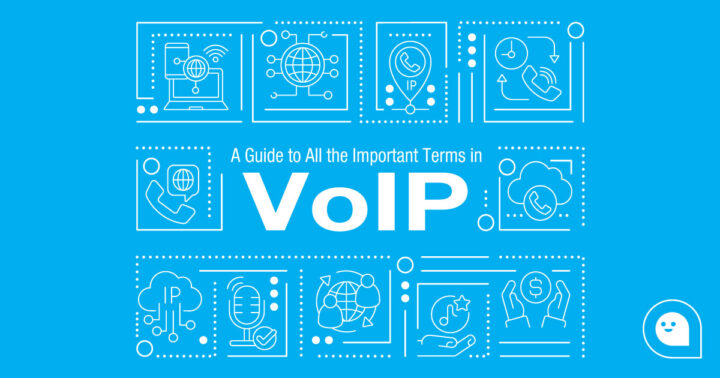VoIP Terms
If you are new to the VoIP industry you might just be a little overwhelmed with all the different terminology and acronyms used. Here is a guide to navigate the essential terms in our industry.
SIP: Session Initiation Protocol – A signaling protocol which initiates, maintains, manages and terminates real-time VoIP sessions
SIP Trunks: are a digital equivalent of traditional phone lines, utilizing the Session Initiation Protocol (SIP) to connect a private branch exchange (PBX) to the internet.
PBX: Private Branch Exchange – a private telephone network used within a company or organization to manage inbound and outbound calls, internal communication, and call routing. It allows users to have more phones than physical phone lines and offers features like call transfers, voicemail, call recording, interactive voice menus (IVRs), and conference calling.
RTP: Real-time Transport Protocol – a standard protocol used for delivering audio and video over IP networks, such as the internet. RTP is designed to provide end-to-end network transport functions suitable for applications transmitting real-time data, such as streaming media, telephony, and video conferencing services. It helps manage the timely delivery of multimedia data by packetizing it and adding sequence numbers and timestamps to enable the correct ordering and synchronization of the content at the receiver’s end
QoS: Quality of Service – a network feature that prioritizes certain types of data traffic to ensure optimal performance for critical applications. It’s crucial for managing bandwidth and improving the user experience in environments with limited resources.
PSTN: Public Switched Telephone Network – the traditional network infrastructure used for landline telephones. It operates on a circuit-switched basis, utilizing copper wires to carry analog voice data
POTS: Plain Old Telephone Service – the traditional, analog voice transmission phone system utilizing the copper wire network established by the telecommunications industry.
UC: Unified Communications – a framework that integrates various communication tools and technologies within a business, aiming to streamline and enhance communication processes. UC encompasses voice and video calling, messaging, conferencing, email, and file sharing, allowing for a more connected, collaborative, and efficient work environment.
UCaaS: Unified Communications as a Service – a delivery model where communication and collaboration tools are hosted by a third-party provider and offered over the internet. This approach combines phone service, video conferencing, messaging, and file sharing into a single cloud-based platform, making it accessible from anywhere with internet access.
DaaS: Device as a Service – a cloud computing offering where a service provider delivers virtual desktops to end-users over the internet
PMS: Property Management Systems – a software platform that helps in managing the day-to-day operations of properties, including reservations, guest check-ins and check-outs, room assignments, billing, and maintenance tasks
TLS: Transport Layer Security – It’s a cryptographic protocol designed to provide secure communication over a computer network. TLS is widely used for internet security, ensuring that data transmitted between web servers and browsers remains private and integral
SRTP: Secure Real-time Transport Protocol – an extension of RTP (Real-time Transport Protocol) designed to provide encryption, message authentication, and integrity verification for the data streams in multimedia communications, including VoIP (Voice over Internet Protocol) and video conferencing
ATA: Analog Telephone Adapter – a device that connects traditional analog telephones to a digital or VoIP network. It converts analog voice signals into digital data that can be transmitted over the internet, allowing users to make VoIP calls using their existing telephone hardware.
FXS: Foreign Exchange Service – a port found on analog telephone adapters, PBX systems, and VoIP gateways. It connects to traditional analog devices like telephones or fax machines, enabling them to access a VoIP network
DTMF: Dual Tone Multi Frequency – the signal to the phone company that you generate when you press an ordinary telephone’s touch keys. In the context of VoIP and telecommunications, DTMF tones are used for dialing and for navigating interactive voice response (IVR) menus.
LAN: Local Area Network – a network that connects computers and devices in a limited geographical area such as a home, school, office building, or closely situated buildings.
IVR: Interactive Voice Response – a technology that allows a computer to interact with humans through the use of voice and DTMF tones input via a keypad. In practical terms, IVR systems enable users to navigate a phone system before talking to a live operator by simply speaking or pressing buttons, often used in customer service to direct calls efficiently.
DID: Direct Inward Dialing – a service that allows an organization to allocate individual phone numbers to each person or workstation within its private branch exchange (PBX) system without requiring a separate physical phone line for each connection.
NAT: Network Address Translation – a method used in networking to modify network address information in IP packet headers while in transit across a traffic routing device.
VoLTE: Voice over LTE – a standard for high-speed wireless communication, enabling voice calls over a 4G LTE network instead of the 2G or 3G connections traditionally used by cellular networks.
IMS: IP Multimedia Subsystem – a framework used in telecommunications for delivering IP multimedia services, such as voice, video, and messaging, over IP networks.


